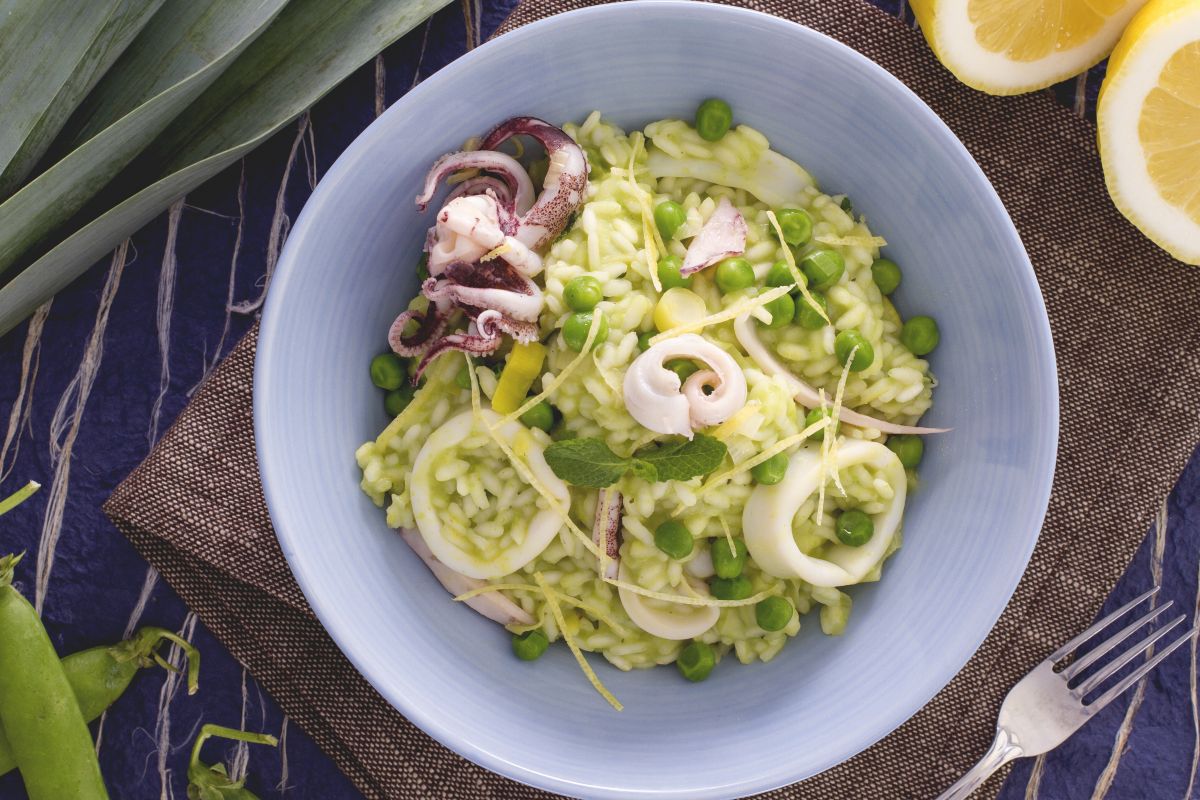Mint, Pea, and Squid Risotto

- Gluten Free
- Lactose Free
- Energy Kcal 434
- Carbohydrates g 62.8
- of which sugars g 5.7
- Protein g 19
- Fats g 10.9
- of which saturated fat g 2.18
- Fiber g 7.8
- Cholesterol mg 48
- Sodium mg 1344
- Difficulty: Easy
- Prep time: 12 min
- Cook time: 30 min
- Serving: 4
- Cost: Average
PRESENTATION
Risotto menta, piselli e calamari is like a taste of summer straight from Northern Italy. And the flavors? Really, really fresh. We're talking mint and lemon mixing with tender calamari. It's like each bite of this risotto con calamari is light, aromatic, and packed with those sweet pops from peas. Seriously good stuff. Quick toss in the pan keeps calamari moist—avoiding that rubbery thing we all hate. Common around Lombardy and Veneto, this method nails a perfect seafood risotto. It’s not heavy at all, which is great.
Plus, the colors? They’re colorful—green peas and mint doing their thing. Variations are everywhere in Northern Italy, often based on whatever's fresh at local markets. Some might go with risotto and pancetta, and creamy pea sauce, but risotto ai piselli e menta or risotto con calamari always wins for a light summer dinner. The mint, I gotta say, gives it a refreshing twist, so it never feels heavy.
Seasoning stays gentle, you know, letting peas and calamari shine, with lemon zest tying it all together. Picture this: enjoying risotto di mare with a chilled white wine on a sunny day—sounds dreamy, right? Whether you stick to the classic or try a local spin, a plate of risotto estivo takes you to an Italian lakeside or coastal spot.
Pretty simple way to bring that summer freshness and Italian vibe into your kitchen, perfect for unwinding after a long day. So, next time you crave something light and delicious, remember this dish—it really captures the essence of a Northern Italian summer. For real, you can't go wrong.
You might also like:
- INGREDIENTS
- Arborio rice 1 ¼ cup (250 g)
- Vegetable broth 4 ¼ cups (1 l)
- Calamari (squid) 10.5 oz (300 g) - (cleaned)
- Peas 1 ½ cup (250 g)
- Mint 5 leaves
- White wine 1.7 oz (50 g)
- Lemons 1
- Leeks 1 ½ cup (140 g)
- Extra virgin olive oil to taste
- Fine salt 1 pinch
- Black pepper to taste
How to prepare Mint, Pea, and Squid Risotto

To make the mint, pea, and squid risotto, start with the squid. If you bought whole squid, clean them following the instructions on our sheet how to clean squid: detach the head and remove the internal cartilage 1, rinse them under running water 2, and remove the skin and fins 3.

Cut the squid into rings 4, then thinly slice the leek 5 and place half of it in a saucepan, add the olive oil and sauté over low heat. Then pour in a ladle of Vegetable broth 6 and continue cooking to soften the leek; this will take at least 5 minutes.

Add the rice at this point 7, toast it for a few minutes, then deglaze with white wine 8. Continue cooking the risotto by occasionally adding a ladle of broth 9.

In another pan, sauté the remaining half of the leek with a drizzle of olive oil, soften over low heat for 5 minutes, add the peas 10, and continue cooking, adding broth little by little to prevent the vegetables from drying out. Cook for 10-15 minutes, then take 3-4 tablespoons of peas 11, transfer them to a tall and narrow container, and blend with an immersion blender 12

to obtain a homogeneous cream 13. Meanwhile, as the rice continues to cook, prepare the squid: slice the lemon zest into strips 14 and squeeze out the juice 15.

Separately, sauté the squid rings in a pan with a drizzle of olive oil and salt 16. Flavor with lemon juice 17 and zest 18.

Then incorporate the peas 19 and flavor with chopped mint. Meanwhile, the risotto will be cooked; season it with the pea cream 20 and mix to combine the ingredients 21.

Finally, add the sautéed squid 22. Stir everything, keeping the heat very low 23, and serve the mint, pea, and squid risotto hot 24.